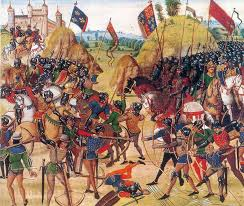The Hundred Years’ War is one of history’s most fascinating conflicts. Spanning over a century from 1337 to 1453, it’s a tale of dynastic disputes, legendary battles, and evolving warfare. While the Battle of Agincourt often steals the spotlight, this prolonged struggle between England and France offers much more for those willing to delve deeper. Let’s embark on a journey through its twists, turns, and key moments.
What Sparked the Hundred Years’ War?
To understand the Hundred Years’ War, you need to rewind to the 14th century. At its heart, the war was a dynastic dispute. The English monarchy, through its Norman and Angevin roots, had long-held claims in France. When Charles IV of France died without a male heir in 1328, England’s Edward III claimed the French throne as the son of Charles’s sister, Isabella. This claim clashed with that of Philip VI, a cousin of Charles IV, who became king under Salic law, which excluded inheritance through the female line. Cue a conflict that would last 116 years.

The Role of Feudal Loyalties
Feudalism played a significant role in complicating loyalties. English kings held vast territories in France, including Aquitaine. These lands made the English monarchs vassals to the French crown, creating a tense, almost paradoxical relationship. Imagine being beholden to your biggest rival that was England’s position in medieval France.
The Early Stages: England’s Dominance
The Battle of Crécy (1346)
The first major phase of the war saw English dominance, marked by key victories like the Battle of Crécy. In this 1346 encounter, Edward III’s forces, including the famed English longbowmen, decimated a much larger French army. The longbow’s range and rapid-fire capabilities revolutionized medieval warfare.
The Black Death’s Impact
Just as England gained the upper hand, Europe was struck by the Black Death. This devastating pandemic, killing millions, temporarily paused hostilities but also reshaped the socio-economic landscape. Both England and France struggled to recover, with depleted populations affecting armies and economies.
The Rise of Chivalry and the Chevauchées
What Were Chevauchées?
A hallmark of the Hundred Years’ War was the chevauchée a scorched earth strategy employed by the English. Armies would raid French countryside, burning villages and crops to weaken their enemy’s resources. It was brutal but effective, striking fear into the hearts of the French populace.
Chivalry’s Double-Edged Sword
The era’s code of chivalry added complexity to warfare. Knights were bound by honor, but battles were rarely noble. The contrast between idealistic depictions of knightly valor and the grim realities of medieval combat couldn’t be starker.
Agincourt: A Singular Victory
No discussion of the Hundred Years’ War is complete without mentioning the Battle of Agincourt in 1415. Henry V’s underdog victory remains iconic, thanks to Shakespeare’s rousing portrayal in Henry V. Outnumbered, the English army leveraged the muddy terrain and their longbows to devastating effect, leaving thousands of French knights dead.
Beyond Agincourt: The Later Years
Joan of Arc’s Role
The latter phase of the war saw France reclaiming its strength, thanks in part to Joan of Arc. This peasant girl turned warrior claimed divine visions guided her to lead France to victory. Her triumph at the Siege of Orléans in 1429 reinvigorated French morale and turned the tide of the war.
The Treaty of Troyes
The Treaty of Troyes in 1420 seemed to seal English dominance. It recognized Henry V as the heir to the French throne, sidelining Charles VII. However, Henry’s untimely death in 1422 disrupted these plans, leaving a nine-month-old son, Henry VI, to inherit both thrones.
How Warfare Evolved During the Conflict
The Decline of the Knight
The Hundred Years’ War marked the decline of the traditional knight. Battles like Crécy and Agincourt highlighted the vulnerabilities of heavily armored cavalry against well-organized infantry and ranged weapons.
Gunpowder’s Arrival
Gunpowder weapons began making their mark, with cannons used in sieges becoming more common. These technological advancements would eventually render castle defenses obsolete, forever altering European warfare.
The Secret Weapon That Made Nvidia the World’s Most Valuable Company
The Endgame: France Emerges Victorious
By the mid-15th century, France had regained most of its territories. Charles VII’s reforms, including a standing army and improved taxation, strengthened the French state. In 1453, the Battle of Castillon marked the war’s end and the effective expulsion of the English from France, except for Calais.
The Hundred Years’ War’s Legacy
Nation-Building
The war played a crucial role in shaping national identities. England and France emerged as more centralized and distinct nations, setting the stage for modern statehood.
Language and Culture
In England, the war’s outcome diminished French cultural influence. The English language gained prominence, evolving into what we recognize today as Middle English.
Economic Consequences
The war’s economic toll was immense, with devastated farmlands and disrupted trade. However, it also spurred innovation, particularly in military tactics and technologies.
Myths and Misconceptions
Was It Really a Single War?
Despite its name, the Hundred Years’ War wasn’t one continuous conflict but a series of wars and truces. It’s more accurate to view it as a prolonged struggle punctuated by periods of uneasy peace.
The Myth of the Invincible Longbow
While the English longbow was undoubtedly effective, its reputation often overshadows the complexities of medieval warfare. Factors like terrain, weather, and leadership were equally crucial in battles.
The Human Cost
The war’s human cost is staggering. Tens of thousands died, not just from combat but also from famine and disease exacerbated by the conflict. Entire communities were uprooted, leaving scars that lasted generations.
Why It Still Matters
A Window into Medieval Europe
Studying the Hundred Years’ War offers invaluable insights into medieval politics, society, and culture. It’s a microcosm of the challenges and transformations of the time.
Lessons for Modern Conflicts
The war’s lessons from the importance of leadership to the impact of technological innovation remain relevant in understanding modern warfare.
Conclusion
The Hundred Years’ War is far more than just the Battle of Agincourt. It’s a story of resilience, transformation, and the human spirit’s capacity to endure. By looking beyond the famous battles, we gain a richer understanding of this pivotal period in history.
FAQs
1. Why did the Hundred Years’ War last so long?
The war’s length is due to intermittent fighting, frequent truces, and the complex political dynamics between England and France.
2. What role did the Black Death play in the war?
The Black Death disrupted both countries, pausing conflicts and reducing available manpower, which influenced military strategies and outcomes.
3. How did Joan of Arc change the course of the war?
Joan’s leadership and victories, particularly at Orléans, boosted French morale and helped turn the tide against English dominance.
4. What innovations emerged from the Hundred Years’ War?
Key innovations included the use of the longbow, gunpowder weaponry, and the shift towards standing armies instead of feudal levies.
5. How did the war shape modern Europe?
The war centralized power in both England and France, fostering the development of national identities and modern statehood.


